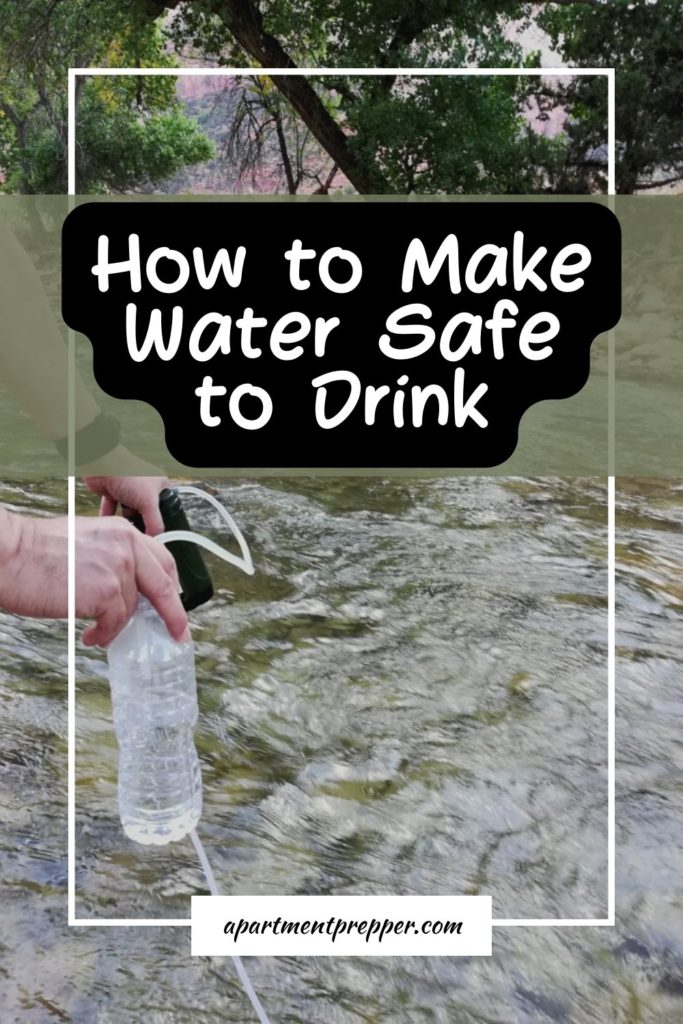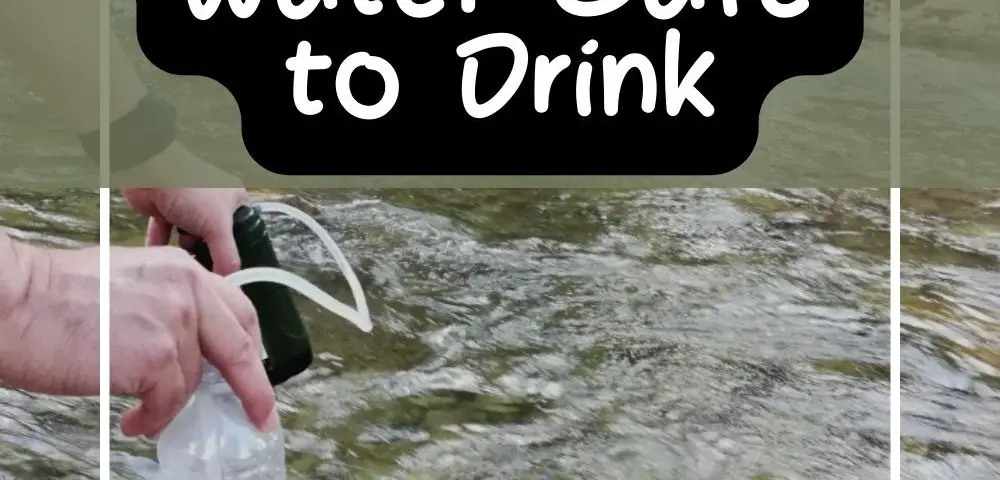Written by Bernie Carr
I’ve been in a couple of natural disasters where the water from the tap became unsafe to drink. It has also happened when the water main in my area was being repaired and we were under a “boil water” notice. According to the survival rule of three, you can survive just three days without water. Because water is one the essential needs for survival, I advise everyone to store water, and choose a method (or two) to treat water for safe drinking.
Today we’ll cover various ways to make water safe to drink.
Remove soil and debris before treating the water
Removing solids from water is the first step you need to take prior to purifying the water. If you collect water from an outdoor source, you’ll need to eliminate any solid particles such as leaves, soil, rocks, or debris before treating the water. Use a bandanna, t-shirt, coffee filter or paper towel – anything that can act as a barrier that can catch dirt.
Treat the water
Chemical treatments
- Using plain unscented chlorine household bleach (5.25% to 5% concentration of sodium hypochlorite) is an example of chemical treatments. You’ll need to measure the amount bleach using a dropper or teaspoon. This article provides more details. If you prefer to use water purifying in tablet form, AquaTabs is another option.
- Another chemical method is iodine. We tested Polar Pure and posted the results.
Chemical water treatment is an inexpensive and convenient option. However, they tend to have limited shelf life and will not protect against metals and other non-biological contaminants.
Boiling
Boiling is another cheap and easy way to clean water. If your county is under a “boil water” order due to a repair or burst water main, then this is all you have to do. All you need is a stove (with fuel) and container for the water. According to the EPA, boiling can kill pathogenic bacteria, viruses and protozoa. Like chemical treatments, boiling does not remove metals, particulates or other chemicals.
- All you have to do is bring water to a rolling boil for at least one minute. If you are at altitudes above 5,000 feet (1,000 meters), boil water for three minutes.
- Boiling water may result in a “flat” taste. To improve the taste of boiled water, add one pinch of salt to each quart or liter of water, or pour the water from one clean container to another a few times. Or, you can add flavoring such as Kool-aid or flavoring.
Mechanical
The Berkey Water filter and Survivor Filter Pro X that I reviewed are examples of mechanical water filtration. They are very efficient and can remove most contaminants including biological, metals, particulates and chemicals. You’ll need to research what they can and can’t do before you buy. They can also take some time to work – check the flow rates as well. You should also be aware you may have to replace certain parts as the filters after a period of time, depending on usage.
Solar
SODIS “solar disinfection.” SODIS is likely the most inexpensive way to disinfect water aside from boiling. All you need is the sun and a plastic or soda bottle. Solar disinfection kills viruses, bacteria, and parasites such as giardia and cryptosporidia in the water. However, SODIS does not get rid of metals or chemical pollutants. For more information on solar disinfection of water, check out my previous article here.
The SteriPen Aqua UV Water Purifier is a device that uses UV light to purify water, and it also removes 99. 9 percent of harmful microorganisms, such as Giardia, bacteria, viruses, and protozoa.
Distillation
Distillation is another method for purifying water. The process involves catching the steam from boiling water, then condense it back to liquid. Distillation removes all contaminants in the water, but it will also remove helpful minerals. One of our previous articles describes distillation in detail. It can be time-consuming and yield very little water. An example of a distillation device that does this is Mophorn Pure Water Distiller.
If you found this article interesting or helpful, please consider helping us out (without costing you anything)! We are an affiliate of Amazon.com, which means we received a small commission if you click through one of our Amazon links when you shop, at totally no cost to you. This helps keep the lights on at the blog. Thanks!
Bernie Carr is the founder of Apartment Prepper. She has written several books including the best-selling Prepper’s Pocket Guide, Jake and Miller’s Big Adventure, The Penny-Pinching Prepper and How to Prepare for Most Emergencies on a $50 a Month Budget. Bernie’s latest e-book, FRUGAL DIY has just been released on Amazon. Her work appears in sites such as the Allstate Blog and Clark.com, as well as print magazines such as Backwoods Survival Guide and Prepper Survival Guide. She has been featured in national publications such as Fox Business and Popular Mechanics. Learn more about Bernie here.




Thank you for the compilation of disinfection methods. Would you elaborate on the longer boiling times at elevation?
I read: “If you are at altitudes above 5,000 feet (1,000 meters), boil water for three minutes.” 1000 meters is 3281feet. How high is high enough to require longer boiling time?
Hi James, Good question, and I did a bit of research to address it. Some experts say that just bringing the water to boil is sufficient enough. However, others such as the EPA and CDC indicate that at 5000 feet, it should be boiled at 3 minutes. According to William Forgey, MD, author of many wilderness and camping books, at high altitudes the boiling point of water is reduced. Normally, water boils at 212 °F while at 25000 feet, the boiling point of water is 185°F. From The Prepper’s Medical Handbook: “It will never be necessary to boil water longer than 5 minutes, and the shortest time mentioned (just bringing water to a boil) will suffice for a safe drinking water. This water will not be sterile, but it will be safe to drink.”